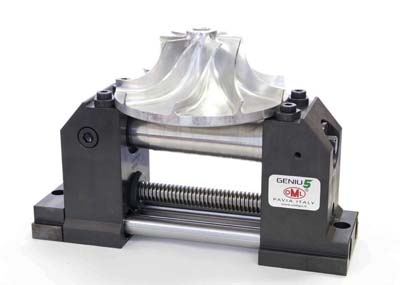Genius Vise
Genius Vise
OML's new Genius 5-axis vice from Lexair Inc. reportedly turns workholding concepts on their head with a unique design that maximizes clamp force at the top of the jaws by pulling them closed at the top with a collapsing lead screw, while holding the bottom of the jaws in place with an opposing force screw.

OML's new Genius 5-axis vice from Lexair Inc. reportedly turns workholding concepts on their head with a unique design that maximizes clamp force at the top of the jaws by pulling them closed at the top with a collapsing lead screw, while holding the bottom of the jaws in place with an opposing force screw. The dual-screw, pull-to-close Genius vice completely eliminates the tendency of traditional vice jaws to splay apart at the top, which requires machine operators to hammer a workpiece down against the stops as the jaws close and clamp force increases. By holding the vice jaws apart at the bottom and pulling closed at the top, the Genius vice actually pulls the workpiece down against the stops as closing force increases. The Genius vice is available in two sizes, capable of holding parts up to 8 inches, with maximum clamp force of 9,000 pounds.
The Genius vice is specifically designed for precision 5-axis milling with trunion-table machines. The adaptable vice easily secures oddly-shaped workpieces, such as turbine blades and blisks, and presents them to the spindle with minimal obstruction, reducing setups and ensuring repeatability of 0.0008".
Intended for production machining, the vice is built with precision, hardened and ground steel components. The jaws are guided on two heavy steel shafts, allowing quick, accurate centering on a pallet or machine table. A telescoping stainless steel cover fully encloses the collapsing lead screw to protect it from chips and coolant.
The Genius vice comes standard with one pair of positioning keys, grippers and wrench. A wide variety of stops, jaw plates, gripper inserts and other accessories are available. Custom opening sizes and other variations are available on request.





